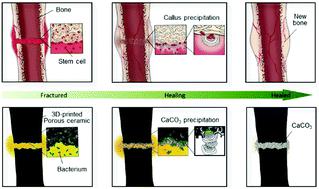当前位置:
X-MOL 学术
›
Mater. Horiz.
›
论文详情
Our official English website, www.x-mol.net, welcomes your feedback! (Note: you will need to create a separate account there.)
Bone-inspired healing of 3D-printed porous ceramics
Materials Horizons ( IF 13.3 ) Pub Date : 2020-06-16 , DOI: 10.1039/d0mh00131g An Xin 1, 2, 3, 4 , Kunhao Yu 1, 2, 3, 4 , Runrun Zhang 1, 2, 3, 4 , Bingyuan Ruan 1, 2, 3, 4 , Allyson L. McGaughey 1, 2, 3, 4 , Zhangzhengrong Feng 1, 2, 3, 4 , Kyung Hoon Lee 1, 2, 3, 4 , Yong Chen 2, 3, 4, 5 , Amy E. Childress 1, 2, 3, 4 , Qiming Wang 1, 2, 3, 4
Materials Horizons ( IF 13.3 ) Pub Date : 2020-06-16 , DOI: 10.1039/d0mh00131g An Xin 1, 2, 3, 4 , Kunhao Yu 1, 2, 3, 4 , Runrun Zhang 1, 2, 3, 4 , Bingyuan Ruan 1, 2, 3, 4 , Allyson L. McGaughey 1, 2, 3, 4 , Zhangzhengrong Feng 1, 2, 3, 4 , Kyung Hoon Lee 1, 2, 3, 4 , Yong Chen 2, 3, 4, 5 , Amy E. Childress 1, 2, 3, 4 , Qiming Wang 1, 2, 3, 4
Affiliation

|
Emerging 3D-printed ceramics, though showing unprecedented application potential, are typically vulnerable to fractures and unable to heal at room temperature. By contrast, their natural counterparts, human bones, exhibit extraordinary self-healing capability through the activation of stem cell osteoblasts that precipitate mineralized calluses to enable interfacial healing at body temperature. Inspired by bones, we here employ bacteria as artificial osteoblasts to enable healing of 3D-printed porous ceramics at room temperature. The healing behavior relies on bacteria-initiated precipitation of calcium carbonate crystals to bridge fracture interfaces of ceramics. We show that bacteria-loaded porous ceramics can heal fracture interfaces to restore 100% mechanical strength at room temperature, and the healed strength is not compromised by heating up to 500 C or by corrosion of alkalis and oxidants. The bacteria-assisted healing mechanism is revealed by systematic control experiments, and the healing strength is explained by cohesive fracture modeling. We further incorporate this method into 3D-printed ceramics and demonstrate on-demand healing of ceramic dental crowns, ceramic water membranes, and ceramic lattices, and autonomous healing of ceramic armor. As the first-generation healing mechanism of 3D-printed ceramics, this paradigm is expected to open promising avenues for revolutionizing the low-damage-tolerance nature of existing 3D-printed ceramics.
中文翻译:

3D打印多孔陶瓷的骨质修复
新兴的3D打印陶瓷尽管显示出空前的应用潜力,但通常容易断裂并且无法在室温下愈合。相比之下,它们天然的人类骨骼通过激活干细胞成骨细胞而展现出非凡的自我修复能力,这些细胞会沉淀矿化的老茧,从而在体温下实现界面愈合。受骨骼的启发,我们在这里采用细菌作为人造成骨细胞,以在室温下修复3D打印的多孔陶瓷。修复行为取决于细菌引发的碳酸钙晶体沉淀,以弥合陶瓷的断裂界面。我们证明,载有细菌的多孔陶瓷可以治愈断裂界面,从而在室温下恢复100%的机械强度,并不会因加热到500°C或碱和氧化剂的腐蚀而影响愈合强度。通过系统的控制实验揭示了细菌辅助的愈合机制,并通过内聚断裂模型解释了愈合强度。我们进一步将此方法整合到3D打印的陶瓷中,并演示了陶瓷牙冠,陶瓷水膜和陶瓷晶格的按需修复以及陶瓷装甲的自主修复。作为3D打印陶瓷的第一代修复机制,这种范例有望为革新现有3D打印陶瓷的低损伤耐受性特性开辟有希望的途径。愈合强度可以通过内聚断裂模型来解释。我们进一步将此方法整合到3D打印的陶瓷中,并演示了陶瓷牙冠,陶瓷水膜和陶瓷晶格的按需修复以及陶瓷装甲的自主修复。作为3D打印陶瓷的第一代修复机制,这种范例有望为革新现有3D打印陶瓷的低损伤耐受性特性开辟有希望的途径。愈合强度可以通过内聚断裂模型来解释。我们进一步将此方法整合到3D打印的陶瓷中,并演示了陶瓷牙冠,陶瓷水膜和陶瓷晶格的按需修复以及陶瓷装甲的自主修复。作为3D打印陶瓷的第一代修复机制,这种范例有望为革新现有3D打印陶瓷的低损伤耐受性特性开辟有希望的途径。
更新日期:2020-08-03
中文翻译:

3D打印多孔陶瓷的骨质修复
新兴的3D打印陶瓷尽管显示出空前的应用潜力,但通常容易断裂并且无法在室温下愈合。相比之下,它们天然的人类骨骼通过激活干细胞成骨细胞而展现出非凡的自我修复能力,这些细胞会沉淀矿化的老茧,从而在体温下实现界面愈合。受骨骼的启发,我们在这里采用细菌作为人造成骨细胞,以在室温下修复3D打印的多孔陶瓷。修复行为取决于细菌引发的碳酸钙晶体沉淀,以弥合陶瓷的断裂界面。我们证明,载有细菌的多孔陶瓷可以治愈断裂界面,从而在室温下恢复100%的机械强度,并不会因加热到500°C或碱和氧化剂的腐蚀而影响愈合强度。通过系统的控制实验揭示了细菌辅助的愈合机制,并通过内聚断裂模型解释了愈合强度。我们进一步将此方法整合到3D打印的陶瓷中,并演示了陶瓷牙冠,陶瓷水膜和陶瓷晶格的按需修复以及陶瓷装甲的自主修复。作为3D打印陶瓷的第一代修复机制,这种范例有望为革新现有3D打印陶瓷的低损伤耐受性特性开辟有希望的途径。愈合强度可以通过内聚断裂模型来解释。我们进一步将此方法整合到3D打印的陶瓷中,并演示了陶瓷牙冠,陶瓷水膜和陶瓷晶格的按需修复以及陶瓷装甲的自主修复。作为3D打印陶瓷的第一代修复机制,这种范例有望为革新现有3D打印陶瓷的低损伤耐受性特性开辟有希望的途径。愈合强度可以通过内聚断裂模型来解释。我们进一步将此方法整合到3D打印的陶瓷中,并演示了陶瓷牙冠,陶瓷水膜和陶瓷晶格的按需修复以及陶瓷装甲的自主修复。作为3D打印陶瓷的第一代修复机制,这种范例有望为革新现有3D打印陶瓷的低损伤耐受性特性开辟有希望的途径。



























 京公网安备 11010802027423号
京公网安备 11010802027423号